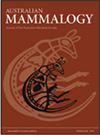Torn limb from limb: the ethology of prey-processing in Tasmanian devils (Sarcophilus harrisii)
IF 1.2
4区 生物学
Q3 ZOOLOGY
引用次数: 3
Abstract
The success of carnivorous mammals is determined not only by their ability to locate and kill prey, but also their efficiency at consuming it. Breaking large prey into small pieces is challenging due to the strong and tough materials that make up a carcass (e.g. hide, muscle, and bone). Carnivores therefore require a diverse suite of prey-processing behaviours to utilise their catch. Tasmanian devils are Australia’s only large marsupial scavengers and have the ability to consume almost all of a carcass. To determine how they do this we analysed 5.5 hours of footage from 21 captive and wild devils feeding at carcasses. We documented 6320 bouts of 12 distinct prey-processing behaviours, performed at frequencies that varied throughout feeds and between groups. The time point in the feed influenced the types of behaviours used. This is likely due to changing prey size, as different techniques appear better suited to handling whole carcasses or large pieces (pulling and pinning) or smaller pieces (holding and manipulating). Group size impacted the frequency of social pulling behaviours, which increased with the number of animals. Our findings highlight the range of prey-processing behaviours performed by scavenging devils when handling, breaking down, and consuming a carcass. The devils’ repertoire shares similarities with large carnivores that handle and consume whole carcasses as well as small carnivores that are adept in grasping and handling smaller prey.从肢体到肢体的撕裂:塔斯马尼亚魔鬼猎物加工的行为学(Sarcophilus harrisii)
食肉哺乳动物的成功不仅取决于它们定位和杀死猎物的能力,还取决于它们消耗猎物的效率。将大型猎物切成小块是很有挑战性的,因为构成尸体的材料(如皮、肌肉和骨头)坚固而坚韧。因此,食肉动物需要一套多样化的猎物处理行为来利用它们捕获的猎物。袋獾是澳大利亚唯一的大型有袋类食腐动物,它们有能力吃掉几乎所有的尸体。为了确定它们是如何做到这一点的,我们分析了21只圈养和野生魔鬼进食尸体的5.5小时镜头。我们记录了6320次12种不同的猎物加工行为,在整个饲料和组之间以不同的频率进行。feed中的时间点影响了所使用的行为类型。这可能是由于猎物大小的变化,因为不同的技术似乎更适合处理整个尸体或大块(拉和钉住)或小块(抓住和操纵)。群体规模影响社会拉扯行为的频率,这种频率随着动物数量的增加而增加。我们的研究结果强调了食腐魔鬼在处理、分解和消耗尸体时所表现出的猎物处理行为的范围。魔鬼的技能与处理并吃掉整个尸体的大型食肉动物和擅长抓握和处理较小猎物的小型食肉动物有相似之处。
本文章由计算机程序翻译,如有差异,请以英文原文为准。
求助全文
约1分钟内获得全文
求助全文
来源期刊

Australian Mammalogy
ZOOLOGY-
CiteScore
2.50
自引率
8.30%
发文量
26
期刊介绍:
Australian Mammalogy is a major journal for the publication of research in all branches of mammalogy. The journal’s emphasis is on studies relating to Australasian mammals, both native and introduced, and includes marine mammals in the Antarctic region. Subject areas include, but are not limited to: anatomy, behaviour, developmental biology, ecology, evolution, genetics, molecular biology, parasites and diseases of mammals, physiology, reproductive biology, systematics and taxonomy.
Australian Mammalogy is for professional mammalogists, research scientists, resource managers, consulting ecologists, students and amateurs interested in any aspects of the biology and management of mammals.
Australian Mammalogy began publication in 1972 and is published on behalf of the Australian Mammal Society.
 求助内容:
求助内容: 应助结果提醒方式:
应助结果提醒方式:


